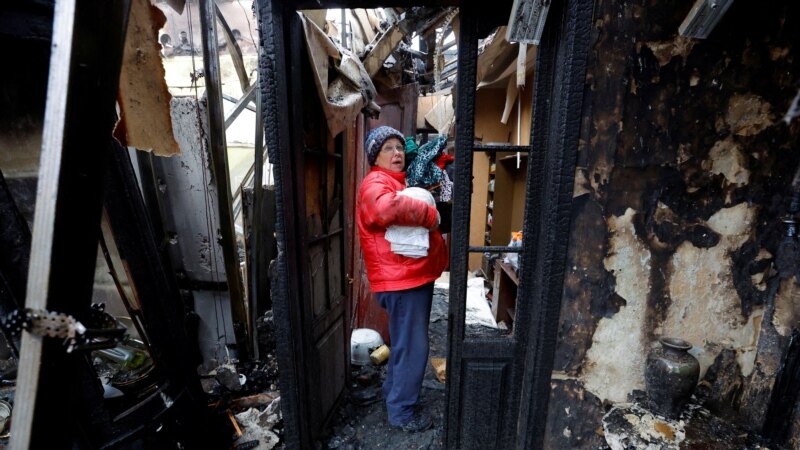
Russian drones attacked Ukraine’s southern port city of Odesa in the early hours of Saturday, leaving the city and the surrounding area without power, local officials said.
“Due to the scale of the damage, all users in Odesa except critical infrastructure have been disconnected from electricity,” Odesa Mayor Gennadiy Trukhanov wrote on Facebook.
Odesa regional Governor Maksym Marchenko said two drones were shot down over the Black Sea before they could fly into their targets.
The drones that did make it through left “no electricity in almost all the districts and communities of our region,” Marchenko wrote on Telegram.
Between Friday and Saturday, the Ukrainian military General Staff reported about 20 airstrikes and more than 60 rocket attacks across Ukraine.
General Staff spokesperson Oleksandr Shtupun said more than 20 populated places came under fire in the Bakhmut district, scene of the most active fighting.
Ukrainian President Volodymyr Zelenskyy said the situation “remains very difficult” in several front-line cities in the eastern Donetsk and Luhansk provinces.
“Bakhmut, Soledar, Maryinka, Kreminna. For a long time, there is no living place left on the land of these areas that have not been damaged by shells and fire,” Zelenskyy said in his nightly video address on Friday, naming cities hardest hit.
If Russian forces capture Bakhmut, they could cut Ukraine’s supply lines and open a route to Kramatorsk and Sloviansk, key Ukrainian strongholds in Donetsk, according to The Associated Press. Russia has battered Bakhmut with rockets for more than half of the year, and shifted troops there for a ground assault after Ukraine drove them from Luhansk in July.
Moscow has “actually destroyed Bakhmut, another Donbas city that the Russian army turned into burnt ruins,” Zelenskyy added in his Friday night address.
Attacks on infrastructure
Since October, Moscow has been targeting Ukraine’s power grid. Kyiv acknowledged Friday that every thermal and hydroelectric power plant in the country had been damaged.
Zelenskyy said the attacks are war crimes targeting civilian life, while Moscow claims they are militarily legitimate.
The chief of the National Police of Ukraine, Ihor Klymenko, said Saturday, that 47,000 Russian war crimes have been recorded in Ukraine since the start of the February 24 invasion. The number includes the torture, rape, and murder of civilians.
Russian President Vladimir Putin is determined to conquer parts of Ukraine and shows no restraint in his brutality, German Chancellor Olaf Scholz said at an event in Potsdam near Berlin, Saturday. But, he added, it is still important to keep a channel of communications open in case an opportunity arises to end the war.
“We are of completely different opinions. Nonetheless I will keep speaking with him because I want to experience the moment where it is possible to get out of this situation. And that’s not possible without speaking with one another,” he said, according to Reuters.
“We have seen the brutality the Russian president is capable of. In Chechnya where he basically eradicated the whole country. Or in Syria. There is no restraint there, it’s as simple as that,” Scholz said.
Scholz also defended his government’s aim to raise defense spending to NATO’s goal of 2% of gross domestic output. He said NATO countries needed to be strong enough that nobody would dare to attack them.
Russia-Iran military partnership
Iran has become one of Russia’s top military backers since the invasion of Ukraine, according to the British Defense Ministry intelligence update posted on Twitter Saturday.
Iran’s support of Russia is likely to grow, the ministry said, because “Russia is attempting to obtain more weapons, including hundreds of ballistic missiles. In return Russia is highly likely offering Iran an unprecedented level of military and technical support that is transforming their relationship.”
“Russia has highly likely expended a large proportion of its stock of its own SS-26 Islander short range ballistic missiles, which carry a 500kg warhead up to 500km,” the ministry said. “If Russia succeeds in bringing a large number of Iranian ballistic missiles into service, it will likely use them to continue and expand its campaign of strikes against Ukraine’s critical national infrastructure.”
In Washington, White House National Security Council spokesman John Kirby said Friday that he was was deeply concerned about the “deepening and burgeoning defense partnership” between Iran and Russia, and that the United States would be using its tools to disrupt that relationship.
U.S. aid to Ukraine
U.S. President Joe Biden authorized a new round of $275 million in military aid for Ukraine, offering new capabilities to defeat drones and boost air defenses, according to a memo released Friday by the White House.
The package also includes rockets for High Mobility Artillery Rocket System (HIMARS) launchers made by Lockheed Martin, 80,000 155 mm artillery rounds, Humvee military vehicles and about 150 generators, according to the memo.
This is the 27th use of presidential drawdown authority for Ukraine, which allows the United States to transfer defense articles and services from stocks quickly without congressional approval in response to an emergency.
In total, the United States has committed $20 billion in security assistance to Ukraine since the beginning of the Biden administration. Since 2014, the United States has committed approximately $22.1 billion in security assistance to Ukraine, and more than $19.3 billion since the beginning of Russia’s invasion in February.
VOA White House Bureau Chief Patsy Widakuswara contributed to this report. Some information for this story came from The Associated Press, Reuters and Agence France-Presse.
